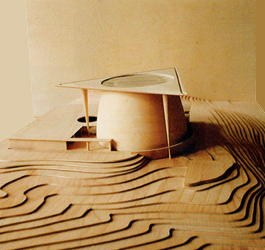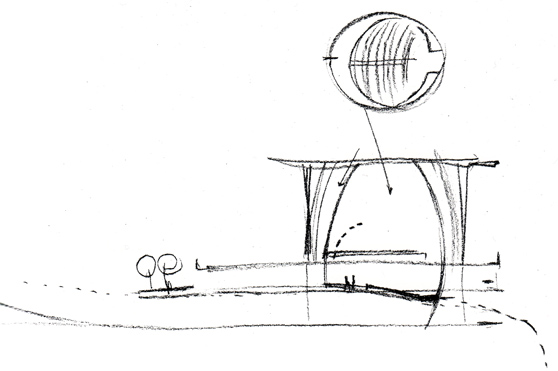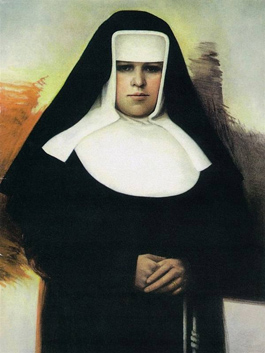
About the new church for Brno's Lesná with Zdeněk Fránek
Zdeněk Fránek stirred the conservative waters of domestic sacral architecture in 2010 with his two realizations of chapels for the Bratrská Church in Černošice and in Litomyšl. Fránek's creative interest in sacral architecture has been mentioned many times in the media, including his fascination with the legacy of Jan Blažej Santini Aichel. Among other things, his proposal for the completion of Santini's pilgrimage church in Křtiny was published. In the mid-90s, Fránek drafted a design for a church for the Brno district of Lesná. In connection with the currently ongoing irregular competition for the design of a church building in Brno-Lesná, we were logically interested in how Zdeněk Fránek stands on this matter and whether he will participate in the competition.
Jan Kratochvíl: Years ago, you published a project for the construction of a church in Lesná in your book Perspectives. Last year, the model of the church was exhibited at the House of Art. Does this design have anything to do with the ongoing architectural competition?
Zdeněk Fránek: Yes, this is the design of the church that I prepared for the parish in Lesná years ago. Today, only the base has been realized in a slightly modified form. Nevertheless, there is still a valid zoning decision for the actual church object, according to which the church should be completed. In this spirit, I am negotiating with the parishioners led by the parish priest Mr. Hověz.
So why did the bishopric announce a new competition for the construction of the church?
I do not know. After the revolution, a competition for this church was announced by the same actors, and after many proposals were submitted, it was canceled without explanation.
The Czech Chamber of Architects declared the competition irregular and urged architects not to participate. Did your copyrights play any role in this decision?
Certainly not just that. The CKA, as far as I know, distanced itself from the competition not only because it violated my copyrights but also because the jury, prizes, etc., were long obscured in the competition. It's very similar to that first competition, which did not turn out as it should have.
What is the history of the church case for Lesná? How did you come to the project?
I do not want to go into details and thereby harm anyone, even though I was treated throughout the process as if I did not exist. Some time at the beginning of the 90s, I was asked to draft a design for a church in Lesná. Several other architects before me failed with their designs at the offices. My design, which was assisted by architect Zdeněk Bureš, who was employed with me at that time, obtained a zoning decision. In the design, I applied my knowledge of vaults and conceived the church as a double parabolic vault. The money then was only enough for the base, which stands there today as a fragment. It was realized in a modified form by Zdeněk Bureš, who became independent in the meantime, which I only learned when the construction of the first phase was finishing. All this happened in the 90s. Then I spent many years contemplating my design, hoping that I would not be bypassed in the subsequent phases at the bishopric. Meanwhile, the church design underwent exhibitions in Prague, Ghent, Utrecht, Hildesheim, etc.
At the beginning of 2011, I was contacted by parishioners from Lesná, who wanted to complete the church, asking me to finish the design. So, I adjusted the design to ensure that the still valid zoning decision was not changed, while at the same time the new church would meet the new needs of the parish. I met many times with the parish priest and the representative of the parish, completing the whole church - for example, I integrated the columns supporting the triangular roof into the body of the outer vault to reduce costs, simplify the construction, and make it more pleasing to the bishop, who reportedly did not like the columns. Thus, our office worked for about a year on the final form of the church. A week before submitting the project, when the last liturgical details were finalized and consulted, the parish priest informed me that Mrs. Veselá from the bishopric decided that she preferred a competition.
Do you think that this decision might be influenced by your unconventional architectural conception of the church?
I do not think so, at least I hope so, because the Lesná housing estate is not a traditional environment for building a church. I think that there are other interests behind the call for the competition. Interestingly, there are different interests of the parishioners from Lesná and different interests of the bishopric. I have always negotiated with the parishioners and the parish priests who will ultimately have to build and pay for it.
How did you actually architecturally conceive the new church?
The construction of the actual temple still utilizes double masonry vaults. The gap between the vaults allows one to ascend to the roof, similar to the churches Santa Maria del Fiore in Florence by Filippo Brunelleschi or London’s St Paul's Cathedral by Christopher Wren. It is an eternal theme with a spiritual foundation, and in this case, it is used in a completely modern way. A magnificent double space with many functions will arise between the vaults, enriching the entire composition with an additional dimension regardless of the spiritual significance and Christian symbolism embedded in this design. Given the high apartment buildings in the vicinity, there is no tower at the church; instead, the top of the body of the church is cut off by a symbolic horizontal triangular roof, which has the only direct lighting of the interior through a ceiling stained glass. The church is extraordinarily symbolic in relation to the fate of Blessed Marie Restituta, who was beheaded by fascists - even Gothic cathedrals had the shape of the execution device - the cross - in their ground plan.
Looking at your design, I wonder if the bishopric does not want to choose an architect with a more conservative view on sacral architecture through the competition. You have positioned yourself as an author of modern churches that evoke strong emotions thanks to the realizations of chapels in Litomyšl and Černošice.
I cannot imagine a more conservative approach than what is in my design. After all, I build on ancient architectures, including the static solution.
I assume that as an authorized architect, you will not participate in the competition.
I have not thought about that at all yet.
How should copyrights be settled in the entire affair?
The best way would be to build the church according to the valid zoning decision.
Thank you for the interview
In the current competition conditions, the jury is already listed:
Jury
Dependent:
Mgr. Pavel Hověz, parish priest in the parish of Brno - Lesná
PhDr. Aleš Filip, Ph.D., Faculty of Arts of Masaryk University in Brno, member of the Council for Liturgical Space of the Brno Bishopric
Ing. arch. Marie Veselá, head of the construction department of the Brno Bishopric and member of the Council for Liturgical Space of the Brno Bishopric
Independent:
Prof. Ing. arch. Jozef Hlinický, Ph.D. Th.D., Catholic University in Ružomberok
Ing. arch. Beata Polomová, PhD., Faculty of Architecture of the Slovak University of Technology in Bratislava
Prof. Dr. Ing. arch. Tomáš Valena, Faculty of Architecture, University of Munich
Prof. Ing. arch. Vladimír Šlapeta, DrSc., Faculty of Architecture, Brno University of Technology
Alternates of the jury:
Ing. Václav Benda
Ing. arch. Damián Berec
doc. Ing. arch. Jaroslav Drápal
doc. Ing. arch. Jiří Mojžíš
Ing. arch. Ladislav Müller
Ing. arch. Lenka Peková
Ing. arch. Petr Todorov
Awards:
1st prize is set at 70,000 CZK
2nd prize is set at 35,000 CZK
3rd prize is set at 15,000 CZK
 |
Zdeněk Fránek: Yes, this is the design of the church that I prepared for the parish in Lesná years ago. Today, only the base has been realized in a slightly modified form. Nevertheless, there is still a valid zoning decision for the actual church object, according to which the church should be completed. In this spirit, I am negotiating with the parishioners led by the parish priest Mr. Hověz.
So why did the bishopric announce a new competition for the construction of the church?
I do not know. After the revolution, a competition for this church was announced by the same actors, and after many proposals were submitted, it was canceled without explanation.
The Czech Chamber of Architects declared the competition irregular and urged architects not to participate. Did your copyrights play any role in this decision?
Certainly not just that. The CKA, as far as I know, distanced itself from the competition not only because it violated my copyrights but also because the jury, prizes, etc., were long obscured in the competition. It's very similar to that first competition, which did not turn out as it should have.
 |
What is the history of the church case for Lesná? How did you come to the project?
I do not want to go into details and thereby harm anyone, even though I was treated throughout the process as if I did not exist. Some time at the beginning of the 90s, I was asked to draft a design for a church in Lesná. Several other architects before me failed with their designs at the offices. My design, which was assisted by architect Zdeněk Bureš, who was employed with me at that time, obtained a zoning decision. In the design, I applied my knowledge of vaults and conceived the church as a double parabolic vault. The money then was only enough for the base, which stands there today as a fragment. It was realized in a modified form by Zdeněk Bureš, who became independent in the meantime, which I only learned when the construction of the first phase was finishing. All this happened in the 90s. Then I spent many years contemplating my design, hoping that I would not be bypassed in the subsequent phases at the bishopric. Meanwhile, the church design underwent exhibitions in Prague, Ghent, Utrecht, Hildesheim, etc.
At the beginning of 2011, I was contacted by parishioners from Lesná, who wanted to complete the church, asking me to finish the design. So, I adjusted the design to ensure that the still valid zoning decision was not changed, while at the same time the new church would meet the new needs of the parish. I met many times with the parish priest and the representative of the parish, completing the whole church - for example, I integrated the columns supporting the triangular roof into the body of the outer vault to reduce costs, simplify the construction, and make it more pleasing to the bishop, who reportedly did not like the columns. Thus, our office worked for about a year on the final form of the church. A week before submitting the project, when the last liturgical details were finalized and consulted, the parish priest informed me that Mrs. Veselá from the bishopric decided that she preferred a competition.
 |
| Blessed Marie Restituta (1.5.1894, Brno-Husovice - 30.3.1943, Vienna) Sister Marie Restituta Kafková was born as Helena Kafková. She took the new name when she was admitted to the Franciscan Order in Vienna in 1915. Most of her life, she worked as a nun and concurrently as a nurse, first in a hospital in Mödling, then in Vienna as head nurse and right-hand woman to the chief physician. She was deeply pious, but asceticism in matters of diet was foreign to her; she suffered from obesity due to excessive consumption of beer and goulash. After the Anschluss of Austria, Sister Marie Restituta encountered Nazi authorities several times, first when she refused their order to remove crucifixes from the hospital premises. On February 18, 1942, she was arrested directly in the operating room and accused of disseminating anti-Nazi materials. On October 29, 1942, she was sentenced to death and beheaded by guillotine on March 30, 1943. The Catholic Church began the beatification process for Sister Marie Restituta in November 1988, and she was declared blessed on June 21, 1998. |
I do not think so, at least I hope so, because the Lesná housing estate is not a traditional environment for building a church. I think that there are other interests behind the call for the competition. Interestingly, there are different interests of the parishioners from Lesná and different interests of the bishopric. I have always negotiated with the parishioners and the parish priests who will ultimately have to build and pay for it.
How did you actually architecturally conceive the new church?
The construction of the actual temple still utilizes double masonry vaults. The gap between the vaults allows one to ascend to the roof, similar to the churches Santa Maria del Fiore in Florence by Filippo Brunelleschi or London’s St Paul's Cathedral by Christopher Wren. It is an eternal theme with a spiritual foundation, and in this case, it is used in a completely modern way. A magnificent double space with many functions will arise between the vaults, enriching the entire composition with an additional dimension regardless of the spiritual significance and Christian symbolism embedded in this design. Given the high apartment buildings in the vicinity, there is no tower at the church; instead, the top of the body of the church is cut off by a symbolic horizontal triangular roof, which has the only direct lighting of the interior through a ceiling stained glass. The church is extraordinarily symbolic in relation to the fate of Blessed Marie Restituta, who was beheaded by fascists - even Gothic cathedrals had the shape of the execution device - the cross - in their ground plan.
Looking at your design, I wonder if the bishopric does not want to choose an architect with a more conservative view on sacral architecture through the competition. You have positioned yourself as an author of modern churches that evoke strong emotions thanks to the realizations of chapels in Litomyšl and Černošice.
I cannot imagine a more conservative approach than what is in my design. After all, I build on ancient architectures, including the static solution.
I assume that as an authorized architect, you will not participate in the competition.
I have not thought about that at all yet.
How should copyrights be settled in the entire affair?
The best way would be to build the church according to the valid zoning decision.
Thank you for the interview
In the current competition conditions, the jury is already listed:
Jury
Dependent:
Mgr. Pavel Hověz, parish priest in the parish of Brno - Lesná
PhDr. Aleš Filip, Ph.D., Faculty of Arts of Masaryk University in Brno, member of the Council for Liturgical Space of the Brno Bishopric
Ing. arch. Marie Veselá, head of the construction department of the Brno Bishopric and member of the Council for Liturgical Space of the Brno Bishopric
Independent:
Prof. Ing. arch. Jozef Hlinický, Ph.D. Th.D., Catholic University in Ružomberok
Ing. arch. Beata Polomová, PhD., Faculty of Architecture of the Slovak University of Technology in Bratislava
Prof. Dr. Ing. arch. Tomáš Valena, Faculty of Architecture, University of Munich
Prof. Ing. arch. Vladimír Šlapeta, DrSc., Faculty of Architecture, Brno University of Technology
Alternates of the jury:
Ing. Václav Benda
Ing. arch. Damián Berec
doc. Ing. arch. Jaroslav Drápal
doc. Ing. arch. Jiří Mojžíš
Ing. arch. Ladislav Müller
Ing. arch. Lenka Peková
Ing. arch. Petr Todorov
Awards:
1st prize is set at 70,000 CZK
2nd prize is set at 35,000 CZK
3rd prize is set at 15,000 CZK
The English translation is powered by AI tool. Switch to Czech to view the original text source.
0 comments
add comment







